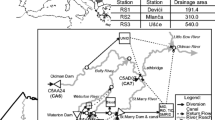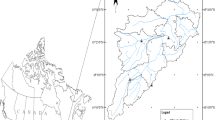Abstract
This paper presents an algorithm for generating stationary stochastic hydrologic time series at multiple sites. The ideas in this paper constitute a radical departure from commonly accepted methodologies. The approach relies on the recent advances in statistical science for simulating random variables with arbitrary marginal distributions and a given covariance structure, and on an algorithm for re-ordering the generated sub-sets of each synthetic year of data such that the annual auto-correlation of desired lag is maintained, along with the autocorrelations between the end of the preceding year and the beginning of the current year. The main features of the proposed algorithm are simplicity and ease of implementation. A numerical test is presented containing the generation of 1000 years of weekly stochastic series for four sites based on the 84 years of historical natural weekly flows from Southern Alberta in Canada.


Similar content being viewed by others
References
Askoy H, Bayazit M (2000) A model for daily flows of intermittent streams. Hydrol Processes 14:1725–1744
Box GEP, Jenkins G (1970) Time series analysis, forecasting and control, 1st edn. Holden Day, San Francisco
Cario MC, Nelson BL (1996) Autoregressive to anything: time series input processes for simulation. Oper Res Lett 19:51–58
Cario MC, Nelson BL (1997) Numerical methods for fitting and simulation autoregressive-to-anything processes. INFORMS J Comput 10:72–81
Cooley WW, Lohnes PR (1971) Multivariate data analysis, Chap 3. Robert E. Krieger Publishing Company, Malabar, Florida
Devore L (1986) Non-uniform random variate generation. Springer, Heidelberg
Ghosh S, Henderson SG (2002) Chessboard distributions and random vectors with specified marginals and covariance matrix. Oper Res 50(5):820–834
Hurst H (1957) A suggested statistical model for some time series that occur in nature. Nature 180:494
Ilich N (2006) A matching algorithm for generating statistically dependent variables with arbitrary marginals. Euro J Oper Res (to appear)
Iman R, Conover W (1982) A distribution free approach to inducing a rank correlation among input variables. Commun Stat Simul Comput 11(3):311–334
Kendall DR, Dracup JA (1991) A comparison of index-sequential and AR(1) generated hydrologic sequences. J Hydrol 122(1–4):335–352
Lall U (1995) Recent advances in nonparametric function estimation: hydrology applications. Review of Geophysics, Supplement, July 1995. U.S. National Report to International Union of Geodesy and Geophysics 1991–1994, pp 1093–1102
Matalas NC (1967) Mathematical assessment of synthetic hydrology. Water Resources Res 3(4):937–945
Mejia JM, Rousselle J (1976) Disaggregation models in hydrology revisited. Water Resources Res 12(2):185–186
Moon YU, Lall U, Bosworth K (1993) A comparison of tail probability estimators for flood frequency analyses. J Hydrol 151:343–363
Rasmussen PF, Salas JD, Fagherazzi L, Rassam JC, Bobbe B (1996) Estimation and validation of contemporaneous PARMA models for streamflow simulation. Water Resources Res 32(10):3151–3160
Sharma A, Tarboton DG, Lall U (1997) Streamflow Simulation: a nonparametric approach. Water Resources Res 33(2):291–308
Srinivas VV, Srinivasan K (2005) Hybrid moving block bootstrap for stochastic simulation of multi-site streamflows. J Hydrol 302:307–330
Sveinsson OGB, Salas JD (2003) Modeling of dynamics of long-term variability of hydroclimatic processes. J Hydrometeorol 4(3):489–505
Thomas HA Jr, Fiering MB (1962) Mathematical synthesis of streamflow sequences for analyses of river basins by simulation. In: Maas A et al (eds) The design of water resources system. Harvard University Press, Cambridge, pp 459–493
UNESCO (2004) IDAMS: internationally developed data analysis and management software package – WinIDAMS Reference Manual, Release 1.2. http://www.unesco.org/idams
US Army Corps of Engineers (1971) HEC-4 User Manual
Valencia DR, Schaake JC (1973) Disaggregation processes in stochastic hydrology. Water Resources Res 9(3):580–585
Acknowledgments
The authors wish to express appreciation to the National Scientific and Engineering Research Council (NSERC) of Canada, and to Golder Associates Ltd. of Calgary, Canada, for jointly sponsoring this research project. The acknowledgment is also extended to Dr. Shuhong Wu of Golder Associates Ltd. for providing his program for low flow and high flow frequency analyses that helped obtain the statistics necessary for compiling information presented in Table 8.
Author information
Authors and Affiliations
Corresponding author
Rights and permissions
About this article
Cite this article
Ilich, N., Despotovic, J. A simple method for effective multi-site generation of stochastic hydrologic time series. Stoch Environ Res Risk Assess 22, 265–279 (2008). https://doi.org/10.1007/s00477-007-0113-6
Published:
Issue Date:
DOI: https://doi.org/10.1007/s00477-007-0113-6




